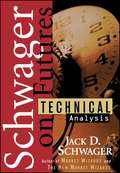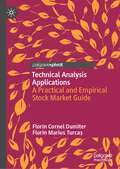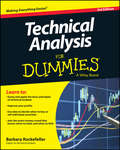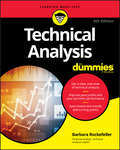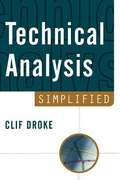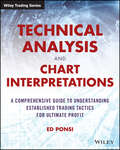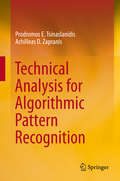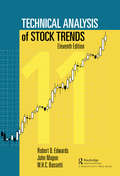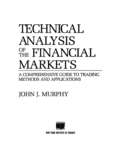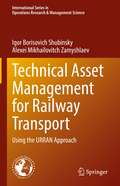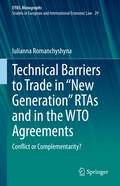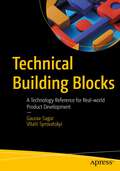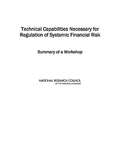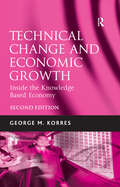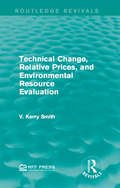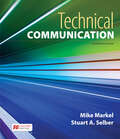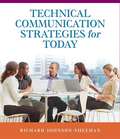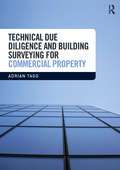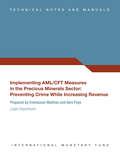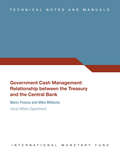- Table View
- List View
Technical Analysis
by Jack SchwagerWith the keen insight and perspective that have made him a market legend, Jack D. Schwager explores, explains, and examines the application of technical analysis in futures trading. In the most in-depth, comprehensive book available, the bestselling investment writer demonstrates why he is one of today's foremost authorities. Here is the one volume no trader should be without.
Technical Analysis Applications: A Practical and Empirical Stock Market Guide
by Florin Cornel Dumiter Florin Marius TurcașThis book integrates technical analysis in the capital markets: stock market theories, valuation approaches, portfolio theories, company analysis. In addition to deepening the overall inspection of technical analysis, the book will challenge the corporate norm and offer alternative theories, sometimes even contrary theories, and explore related areas in the context of increasing investment efficiency. Unlike other research in this area, this approach does not consider technical analysis as an ultimate and absolute truth and recognizes that by studying all aspects of an interdisciplinary problem, the chances of success increase substantially. The book will be of specific interest to academics, students and practitioners of financial markets.
Technical Analysis For Dummies
by Barbara RockefellerA simple, straightforward guide to the fundamentals of technical analysisTechnical analysis is a collection of techniques designed to help you make trading decisions in securities markets. Technical Analysis For Dummies helps you take a hard-headed look at what securities prices are actually doing rather than what economists or analysts say they should be doing, giving you the know-how to use that data to decide whether to buy or sell individual securities.Since the publication of the first edition, readers have been faced with many changes, such as new interest rates, looming bank crises, and adjusting market climates. This new edition provides an updated look at unique formulas and key indicators, as well as refreshed and practical examples that reflect today today's financial atmosphere.Determine how markets are performing and make decisions using real dataSpot investment trends and turning pointsImprove your profits and your portfolio performanceWith straightforward coverage of concepts and execution, Technical Analysis For Dummies shows you how to make better trading decisions in no time.
Technical Analysis For Dummies
by Barbara RockefellerGrasp and apply the basic principles of technical analysis Savvy traders know that the best way to maximize return is to interpret real-world market information for themselves rather than relying solely on the predictions of professional analysts. This straightforward guide shows you how to put this into profitable action—from basic principles and useful formulas to current theories on market trends and behavioral economics—to make the most lucrative decisions for your portfolio. The latest edition of Technical Analysis for Dummies includes a brand-new chapter on making the right decisions in a bull or bear market, an updated look at unique formulas and key indicators, as well as refreshed and practical examples that reflect today today's financial atmosphere. Become an expert in spotting market trends and key indicators Get the skinny on the latest research on behavioral economics Take a deep dive into how to read market sentiment and make it work for you Get a look at the first innovation in charting for decades—straight from Japan With comprehensive coverage from charting basics to the cutting edge, Technical Analysis for Dummies includes everything you need to the make informed independent market decisions that will maximize your profits. Happy trading!
Technical Analysis Simplified
by Clif DrokeWell-known technician and newsletter editor Clif Droke distills the most essential elements of technical analysis of the stock market.
Technical Analysis and Chart Interpretations: A Comprehensive Guide to Understanding Established Trading Tactics for Ultimate Profit (Wiley Trading)
by Ed PonsiEd Ponsi's straightforward guide to understanding technical analysis Technical Analysis and Chart Interpretations delivers simple explanations and easy-to-understand techniques that demystify the technical analysis process. In his usual straightforward style, bestselling author Ed Ponsi guides you through the twists and turns to show you what really matters when it comes to making money. Whether you trade stocks, currencies, or commodities, you'll develop invaluable skills as you master difficult concepts and the tools of the trade. Technical analysis translates to any form of trading, and this book delivers clear, jargon-free guidance toward interpreting the various charts you'll see in the field. Technical analysis can be confusing. Volatility, cycles, Elliot waves, Fibonacci, trends—it's easy to get lost, and most of the available literature is incomprehensible to all but the experts. This book is different—it's technical analysis for the rest of us. You'll see through the language to understand the underlying concepts, and how to apply them correctly. Learn what true technical analysis entails Discover the tools that simplify accurate analysis Master the tactics and strategies used by the pros Develop a valuable trading skill that transcends markets Simply recognizing the vocabulary isn't nearly enough, and a passing acquaintance with the topic is guaranteed to do more harm than good. When technical analysis methods are used incorrectly, they are ineffective at best, and actively destructive to your bottom line at worst. Technical Analysis and Chart Interpretations cuts through the confusion to give you a firm understanding and the skills to apply it correctly.
Technical Analysis for Algorithmic Pattern Recognition
by Achilleas D. Zapranis Prodromos E. TsinaslanidisThe main purpose of this book is to resolve deficiencies and limitations that currently exist when using Technical Analysis (TA). Particularly, TA is being used either by academics as an "economic test" of the weak-form Efficient Market Hypothesis (EMH) or by practitioners as a main or supplementary tool for deriving trading signals. This book approaches TA in a systematic way utilizing all the available estimation theory and tests. This is achieved through the developing of novel rule-based pattern recognizers, and the implementation of statistical tests for assessing the importance of realized returns. More emphasis is given to technical patterns where subjectivity in their identification process is apparent. Our proposed methodology is based on the algorithmic and thus unbiased pattern recognition. The unified methodological framework presented in this book can serve as a benchmark for both future academic studies that test the null hypothesis of the weak-form EMH and for practitioners that want to embed TA within their trading/investment decision making processes.
Technical Analysis of Stock Trends
by Robert D. Edwards John Magee W.H.C. BassettiThis revised and updated version of the best-selling book, Technical Analysis of Stock Trends, 10th Edition, presents proven long- and short-term stock trend analysis enabling investors to make smart, profitable trading decisions. The book covers technical theory such as The Dow Theory, reversal patterns, consolidation formations, trends and channels, technical analysis of commodity charts, and advances in investment technology. The book also includes a comprehensive guide to trading tactics from long and short goals, stock selection, charting, low and high risk, trend recognition tools, balancing and diversifying the stock portfolio, application of capital, and risk management. This sharpened and updated new edition offers patterns and charts that are tighter and more illustrative, including modifiable charts. Expanded material will be offered on Pragmatic Portfolio Theory as a more elegant alternative to Modern Portfolio Theory; and a newer, simpler, and more powerful alternative to Dow Theory is presented.
Technical Analysis of The Financial Markets: A Comprehensive Guide to Trading Methods and Applications (New York Institute Of Finance Ser.)
by John J. MurphyThis outstanding reference has already taught thousands of traders the concepts of technical analysis and their application in the futures and stock markets. Covering the latest developments in computer technology, technical tools, and indicators, the second edition features new material on candlestick charting, intermarket relationships, stocks and stock rotation, plus state-of-the-art examples and figures. From how to read charts to understanding indicators and the crucial role technical analysis plays in investing, readers gain a thorough and accessible overview of the field of technical analysis, with a special emphasis on futures markets. Revised and expanded for the demands of today's financial world, this book is essential reading for anyone interested in tracking and analyzing market behavior.
Technical Asset Management for Railway Transport: Using the URRAN Approach (International Series in Operations Research & Management Science #322)
by Igor Borisovich Shubinsky Alexei Mikhailovitch ZamyshlaevThis book introduces readers to the key provisions of the URRAN-based technical asset management system - a methodology for managing resources and risks by analyzing and ensuring the required levels of reliability and safety in Russia’s railway transport facilities. It describes the architecture of the URRAN information system’s unified corporate platform (UCP URRAN) and its subsystems for infrastructure facilities and rolling stock complexes. It also highlights the UCP URRAN’s prospects for development, especially in the application of artificial intelligence to predict dangerous events in railway transport operation. The book is chiefly intended for specialists engaged in practical work on the technical maintenance of railway transport facilities. It can also be used as a reference guide for students and researchers at railway universities or professionals who are dealing with problems in technical asset management in other industries.
Technical Barriers to Trade in “New Generation” RTAs and in the WTO Agreements: Conflict or Complementarity? (European Yearbook of International Economic Law #29)
by Iulianna RomanchyshynaThis book examines the interplay between cooperation on technical barriers to trade (TBT) in free trade agreements and the multilateral framework of the World Trade Organization. In recent years, TBT, especially differences in standards, have attracted increased interest and have been addressed as part of the WTO+ negotiated agenda in trade agreements. Because of a number of political and legal constraints, the process of further cooperation at the WTO have been stalled, which made free trade agreements a central pillar in setting the agenda of international trade governance. This leads us to rethinking the interrelation between the WTO and free trade agreements and to questioning the role of both fora in the future of trade. The book examines some TBT provisions in free trade agreements and highlights their positive and problematic aspects when it comes to the WTO-consistency and the ideas of open and inclusive trade. It also suggests that a more optimal way forward would be to increase parallel work on TBT cooperation at the WTO, a more inclusive forum that could address issues of global significance, such as environmental protection and regulation of digital goods. The book explores the potential for trade agreements to advance the WTO agenda, but notes that the organization would need to adapt its institutional structure and governance in order to do so.Drawing on the example of the EU and US so-called “new generation” trade agreements, the book provides a detailed analysis of the various methods used to navigate TBT cooperation, and offers insight into how these agreements can serve as inspiration for future multilateral disciplines. This book is a valuable resource for trade law academics, policymakers, and anyone interested in the intersection of technical barriers to trade, regional trade agreements, and the WTO.
Technical Building Blocks: A Technology Reference for Real-world Product Development
by Gaurav Sagar Vitalii SyrovatskyiThis book offers comprehensive coverage of the various technologies and techniques used to build technical products. You will learn how technical product development is collaboratively done across multiple technical teams, primarily those in software engineering, data engineering, and AI/ML engineering. You will also be introduced to the technologies these teams use to develop features and products. Many roles in the organization work alongside these technical product development teams and act as liaisons between them, the stakeholders, the customers, and the leadership team. The people in these roles must understand technical aspects ranging from system design to artificial intelligence, and be able to engage in technical discussions with the engineering teams to determine the pros, cons, and risks associated with the development of a technology product or feature. Technical Building Blocks will help you master these technical skills. The book has just the right level of technical details to neither overwhelm with unnecessary technical depth, nor be superficial. From concepts to code snippets, authors Gaurav Sagar and Vitalii Syrovatskyi cover it all to give you an understanding of the engineer's mind and their work. Special emphasis on figures and charts will help you grasp complex ideas more quickly. After reading this book, you’ll be able to effectively communicate with engineering teams, provide valuable inputs in the system design review meetings of upcoming features and products, synthesize and simplify technical updates for cross-functional teams and stakeholders, and pass those dreaded technical interviews at your dream companies. What You Will Learn Intrinsic details of the teams and techniques used for product development Concepts of cloud computing and its deployment modelsSystem design fundamentals required to architect features and products Evolution of data pipelines and data storage solutions to support big dataML and deep learning algorithms to build intelligence into productsSecuring products through identity and access management using cryptographyRole and working of blockchains, smart contracts, NFTs, and dApps in Web3 Who This Book is For Professionals in roles who work with software engineering teams and want to build their technical muscle, such as product managers, program managers, business analysts, project managers and product owners. Also useful for those preparing to crack the technical interview for these roles.
Technical Capabilities Necessary for Regulation of Systemic Financial Risk: Summary of a Workshop
by National Research Council of the National AcademiesThe financial reform plans currently under discussion in the United States recognize the need for monitoring and regulating systemic risk in the financial sector. To inform those discussions, the National Research Council held a workshop on November 3, 2009, to identify the major technical challenges to building such a capability. The workshop, summarized in this volume, addressed the following key issues as they relate to systemic risk: What data and analytical tools are currently available to regulators to address this challenge? What further data-collection and data-analysis capabilities are needed? What specific resource needs are required to accomplish the task? What are the major technical challenges associated with systemic risk regulation? What are various options for building these capabilities? Because every systemic event is unique with respect to its specific pathology--the various triggers and the propagation of effects--the workshop focused on the issues listed above for systemic risk in general rather than for any specific scenario. Thus, by design, the workshop explicitly addressed neither the causes of the current crisis nor policy options for reducing risk, and it attempted to steer clear of some policy issues altogether (such as how to allocate new supervisory responsibilities). More than 40 experts representing diverse perspectives participated in the workshop.
Technical Change and Economic Growth: Inside the Knowledge Based Economy
by George M. KorresTechnological change is not only a determinant of growth but is also a pivotal factor in international competition and the modernization of an economy. In one of the most in-depth and detailed studies of its kind, George Korres analyzes the macroeconomic and the microeconomic factors influencing the economics of innovation and the economic relations between technology, innovation, knowledge and productivity. In particular, this book examines both the theoretical framework and the applications for empirical results. This second edition contributes updated figures and estimations for technical change from EU member states and features new subjects, including growth models, productivity models, production function models and non-parametric models. In one of the most in-depth and detailed studies of its kind, this book captures all the existing contemporary techniques in the theoretical fields as well as the empirical applications of the models.
Technical Change, Relative Prices, and Environmental Resource Evaluation (Routledge Revivals)
by V. Kerry SmithOriginally published in 1974, Technical Change, Relative Prices, and Environmental Resource Evaluation explores the relationship between natural environmental resources and the differential implications of technological change and relative price appreciation. Smith claims that price is linked to technological progress and comments on the economic issues surrounding this. This title will be of interest to students of Environmental Studies and Economics.
Technical Communication
by Stuart A. Selber Mike MarkelMake the leap from writing in college to writing in a variety of workplace settings and contexts with Technical Communication. Practical advice and real-world examples let you practice with the kinds of writing processes and products you’ll encounter on the job.
Technical Communication Strategies for Today
by Richard Johnson-SheehanTechnical Communication Strategies for Today offers students all of the topics and genres they need for their technical communication course. Students want their textbooks to cost less, and they want comprehensive topical coverage presented in a succinct and clear writing style. Technical Communication Strategies for Today offers both and speaks to today's students. Instructional narrative is "chunked," so that portions of text are combined with graphics. The chunked presentation also integrates an awareness of how documents are read-often skimmed by readers seeking the information they need, and it models the way today's technical documents should be designed. The contemporary writing style is matched by an approach that accurately reflects the modern day computer-centered technical workplace: Technical Communication Strategies for Today presents computers as thinking tools that powerfully influence how we develop, produce, design, and deliver technical documents and presentations.
Technical Data Corp.
by William A. SahlmanDescribes a decision confronting the president of a small company about selling some or all of the shares in his company to another firm. Technical Data Corp. provides analytical services to professional bond market traders over a system of computer terminals operated by Telerate. The company began operation in 1980 and has been very successful. The key issues in the case are: how the value of the company should be estimated and what a reasonable negotiating strategy for the potential sale of the company is.
Technical Data Corp.: Business Plan
by William A. SahlmanContains materials extracted from a business plan developed by the company in 1980. The purpose of the business plan was to raise $100,000 to finance the commencement of operations. The firm intended to provide analytical services to bond market traders. The product would be distributed to traders over a system of computer terminals operated by Telerate. Intended to act as a vehicle for discussing business plans per se, and how one decides to invest in new ventures more generally.
Technical Due Diligence and Building Surveying for Commercial Property
by Adrian TaggTechnical Due Diligence and Building Surveying for Commercial Property is the first book to introduce the process of technical due diligence (TDD) and examine the role of the building surveyor within the commercial property sector. The book outlines the processes that the surveyor must go through when performing a TDD inspection and report and, most importantly, covers in detail the typical pathology and defects encountered during TDD. Performing a TDD survey involves collecting, analysing and reporting on a huge amount of information, often under specific contractual conditions. The book covers everything the surveyor needs to know in order to do a proper job and includes analysis of materials, life cycles and potential defects on an elemental basis, with detail on individual components where necessary. Coverage includes: • an introduction to the TDD process and types of commercial buildings encountered • chapters outlining the life cycle and defects of: structures, roofs, facades, finishes and services • hundreds of illustrations and photographs of defects, real-world case studies and suggestions for further reading • a final chapter covering legal issues and technical details. This book fills a clear gap in the literature and is the first fully illustrated book on TDD dedicated to commercial building stock. It will help students and professionals to understand the process, the science involved and the reasons why defects occur, as well as their evolution and long-term impact.
Technical Note and Discussion on Real Estate Valuation (IBET): Back of the Envelope (BOE) on Bonhomme Place, A Case within a Case
by Arthur I SegelDiscusses real estate valuation. Reviews "back of the envelope" valuation; real estate appraisal methods, including the income method; market comparables and replacement costs; and more complex computer modeling. Also discusses other variables that could influence valuation.
Technical Note on Financial Leverage in Real Estate
by Arthur I Segel Charles F WuDemonstrates the accelerating impact of leverage on returns under differing scenarios of property performance. The performance scenarios represent two points in time: the inception of the investment and the liquidation.
Technical Note on LBO Valuation (B): The Equity Cash Flow Method of Valuation Using CAPM
by Carliss Y. BaldwinExplains the equity cash flow method of valuation as it applies to leveraged buyouts. Also explains how to implement the changing cost of equity method using the CAPM.
Technical Notes and Manuals
by Emmanuel Mathias Bert FeysA report from the International Monetary Fund.
Technical Notes and Manuals
by International Monetary FundThis technical note and manual (TNM) addresses the following main issues: -Interaction between treasury cash management and monetary policy operations within the wider context of the respective economic responsibilities of the ministry of finance and the central bank. -Institutional arrangements for an effective relationship between the treasury and the central bank. -Contractual arrangements between the treasury and the central bank for the provision of banking and other services. This document will be particularly relevant to developing countries that are reforming cash management operations or contemplating more active cash management; or where there are operational policy differences between the treasury and the central bank.
